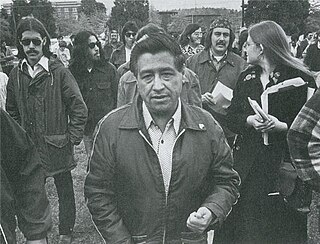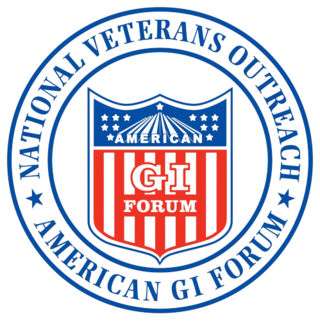Related Research Articles

Tejanos are the residents of the state of Texas who are culturally descended from the Mexican population of Tejas and Coahuila that lived in the region prior to it becoming what is now known as the state of Texas before it became a U.S. state in 1845. The term is also sometimes applied to all Texans of Mexican descent.

Mexican Americans are Americans of full or partial Mexican heritage. In 2019, Mexican Americans comprised 11.3% of the US population and 61.5% of all Hispanic and Latino Americans. In 2019, 71% of Mexican Americans were born in the United States, though they make up 53% of the total population of foreign-born Latino Americans and 25% of the total foreign-born population. The United States is home to the second-largest Mexican community in the world, behind only Mexico. Most Mexican Americans reside in the Southwest.

Mexican Texas is the historiographical name used to refer to the era of Texan history between 1821 and 1836, when it was part of Mexico. Mexico gained independence in 1821 after winning its war against Spain, which began in 1810. Initially, Mexican Texas operated similarly to Spanish Texas. Ratification of the 1824 Constitution of Mexico created a federal structure, and the province of Tejas was joined with the province of Coahuila to form the state of Coahuila y Tejas.

Mexican American history, or the history of American residents of Mexican descent, largely begins after the annexation of Northern Mexico in 1848, when the nearly 80,000 Mexican citizens of California, Nevada, Utah, Arizona, Colorado, and New Mexico became U.S. citizens. Large-scale migration increased the U.S.' Mexican population during the 1910s, as refugees fled the economic devastation and violence of Mexico's high-casualty revolution and civil war. Until the mid-20th century, most Mexican Americans lived within a few hundred miles of the border, although some resettled along rail lines from the Southwest into the Midwest.

Peter M. Holt is an American businessman. He is the former CEO of HoltCat, the largest Caterpillar dealership in the United States and former chairman, CEO, and owner of Spurs Sports & Entertainment, which owns the NBA's San Antonio Spurs, the USL's San Antonio FC, the AHL's San Antonio Rampage, and the NBA G League's Austin Spurs.

Héctor Pérez García was a Mexican-American physician, surgeon, World War II veteran, civil rights advocate, and founder of the American GI Forum (AGIF). As a result of the national prominence he earned through his work on behalf of Hispanic Americans, he was instrumental in the appointment of Vicente T. Ximenes, a Mexican American and AGIF charter member, to the Equal Employment Opportunity Commission in 1966.

The Chicano Movement, also referred to as El Movimiento, was a social and political movement in the United States inspired by prior acts of resistance among people of Mexican descent, especially of Pachucos in the 1940s and 1950s, and the Black Power movement, that worked to embrace a Chicano/a identity and worldview that combated structural racism, encouraged cultural revitalization, and achieved community empowerment by rejecting assimilation. Before this, Chicano/a had been a term of derision, adopted by some Pachucos as an expression of defiance to Anglo-American society. With the rise of Chicanismo, Chicano/a became a reclaimed term in the 1960s and 1970s, used to express political autonomy, ethnic and cultural solidarity, and pride in being of Indigenous descent, diverging from the assimilationist Mexican-American identity. Chicanos also expressed solidarity and defined their culture through the development of Chicano art during El Movimiento, and stood firm in preserving their religion.

Partido Nacional de La Raza Unida is a former Hispanic political party centered on Chicano (Mexican-American) nationalism. It was created in 1970 and became prominent throughout Texas and Southern California. It was started to combat growing inequality and dissatisfaction with the Democratic Party that was typically supported by Mexican-American voters. After its establishment in Texas, the party launched electoral campaigns in Colorado, Arizona, New Mexico, and California, though it only secured official party status for statewide races in Texas. It did poorly in the 1978 Texas elections and dissolved when leaders and members dropped out.

The American GI Forum (AGIF) is a congressionally chartered Hispanic veterans and civil rights organization founded in 1948. Its motto is "Education is Our Freedom and Freedom should be Everybody's Business". AGIF operates chapters throughout the United States, with a focus on veterans' issues, education, and civil rights. Its two largest national programs are the San Antonio-based Veterans Outreach Program, and the Dallas-based Service, Employment, Redevelopment-Jobs for Progress, Inc. (SER). The current National Commander is Lawrence G. Romo.
Gustavo "Gus" C. Garcia was an American civil rights attorney. Garcia worked with fellow attorney Carlos Cadena in the landmark case Hernández v. Texas (1954), arguing before the US Supreme Court for the end of a practice of systematic exclusion of Hispanics from jury service in Jackson County, Texas. Even though Mexican Americans composed more than 10% of the county's population, no person of Mexican ancestry had served on a jury there and in 70 other Texas counties in over 25 years. The high court, led by Chief Justice Earl Warren, ruled that United States citizens could not be excluded from jury duty based on national origin, because such exclusion denied the accused a jury of his peers.

The Odisha Society of the Americas, or OSA, is an organization whose stated goals are to promote the culture of the Indian state of Odisha in the United States and Canada, and to facilitate the exchange of information between Odisha and North America. Founded in 1969, OSA is registered as a 501(c)(3) charitable organization in the United States. The main event of the organization is an annual convention which aims to bring members of the Odia diaspora together to celebrate their ethnic culture. It held an annual get-together called convention, where people of Odia origin from different parts of USA and Canada mingled and shared experiences of ethnic living.

The League of United Latin American Citizens (LULAC) is the largest and oldest Hispanic and Latin-American civil rights organization in the United States. It was established on February 17, 1929, in Corpus Christi, Texas, largely by Hispanics returning from World War I who sought to end ethnic discrimination against Latinos in the United States. The goal of LULAC is to advance the economic condition, educational attainment, political influence, housing, health, and civil rights of Hispanic people in the United States. LULAC uses nationwide councils and group community organizations to achieve all these goals. LULAC has about 132,000 members in the United States.

Jovita Idar Vivero was an American journalist, teacher, political activist, and civil rights worker who championed the cause of Mexican Americans and Mexican immigrants. Against the backdrop of the Mexican Revolution, which lasted a decade from 1910 through 1920, she worked for a series of newspapers, using her writing to work towards making a meaningful and effective change. She began her career in journalism at La Crónica, her father's newspaper in Laredo, Texas, her hometown.
Brown, Not White: School Integration and the Chicano Movement in Houston is a 2005 book by Guadalupe San Miguel, Jr., published by the Texas A&M University Press. Brown, Not White discusses Chicano activism in Houston, Texas during the 20th century.
The following is a timeline of Latino civil rights in the United States.
Manuela Solís Sager (1912-1996) was a Mexican American labor leader, union organizer and educator. She is best known for her work organizing with Mexican women in Texas during the 1930s, where 40% of the total Mexican population were employed almost exclusively in low paid, low status jobs.
José Tomás Canales was an American businessman, lawyer, and politician based in Texas. He served five terms in the State House, where he was the only Mexican-American representative at the time. He is best known for his work on behalf of Mexican-Americans and Tejanos in Texas, defending civil rights of Latin Americans and other minorities.
Adela Sloss-Vento was born Karnes City, Texas to Anselma Garza and David Henry Sloss. As a young American woman of Mexican descent, she was determined to become a writer, hailing from southern Texas, educated in San Juan, later lived in Corpus Christi during World War II, and then settled in Edinburg, she used her pen as weapon for more than sixty years, countering racial discrimination and exploitation of laborers, all the while championing the civil rights of Mexican Americans through the written word.

Alonso S. Perales was a Mexican American lawyer, diplomat, and civil rights activist based in Texas. He was a founder of the League of United Latin American Citizens (LULAC) and served as the second president, helping write its constitution. Perales also served as a diplomat in the Eisenhower administration.
References
- 1 2 3 4 5 6 7 8 9 Cynthia E. Orozco, "ORDER OF SONS OF AMERICA," Handbook of Texas Online (http://www.tshaonline.org/handbook/online/articles/veotu), accessed September 29, 2011. Published by the Texas State Historical Association.
- 1 2 3 4 5 Gutierrez, David G. Walls and Mirrors: Mexican Americans, Mexican Immigrants, and the Politics of Ethnicity. Berkeley, Los Angeles, London: University of California press, 1995. 74-7, 81-2.
- ↑ Wilkie, James W., Meyer, Michael C., Wilkie, Edna Monzon De (1976). Contemporary Mexico: Papers of the IV International Congress of Mexican History. Los Angeles, California: Univ of California Pr. p. 572. ISBN 978-0520028715.
{{cite book}}: CS1 maint: multiple names: authors list (link) - ↑ Barkan, Elliott Robert. Ed. (2013). Immigrants in American History: Arrival, Adaptation, and Integration. Santa Barbara, CA.: ABC-CLIO. pp. 514–516. ISBN 978-1-59884-219-7.
- ↑ Julie Leininger Pycior, La Raza Organizes: Mexican American Life in San Antonio, 1915–1930, as Reflected in Mutualista Activities (Ph.D. dissertation, University of Notre Dame, 1979).
- 1 2 3 4 5 6 Orozco, Cynthia. No Mexicans, Women, Or Dogs Allowed, The Rise Of The Mexican American Civil Rights Movement. Univ of Texas Pr, 2009. <https://books.google.com/books/feeds/volumes?q=0292721323>.
- ↑ Urbina, Martin Guevara; Vela, Joel E.; Sanchez, Juan O. (March 2014). ETHNIC REALITIES OF MEXICAN AMERICANS: From Colonialism to 21st Century Globalization. Charles C Thomas Publisher. p. 63. ISBN 9780398087814.
- ↑ Alienated Citizens: "Hispanophobia" and the Mexican Im/migrant Body. p. 56. ISBN 9780549509714.
- ↑ George, Ann; Weiser, M. Elizabeth; Zepernick, Janet (25 February 2013). Women and Rhetoric between the Wars. SIU Press. p. 222. ISBN 9780809331390.